One of the more unusual bird behaviors I’ve photographed is “foot shipping” in Western Grebes. In fact I’d say it borders on the bizarre.
Yesterday morning I photographed this adult Western Grebe with its leg and foot in the air. Even though I see them do this often I still think it’s a very strange behavior. This image grabbed my attention because of another of those “little things” that often catch my eye. In this case it’s the similar position and angle of the raised wing and raised foot that is repeated in the reflection.
As we’ll soon see there’s good reason for both the elevated foot and the raised wing.
Seeing and photographing the behavior reminded me that it’s been almost exactly 5 years since I explained to blog readers what’s going on here and the reason for it. Knowing that most current readers haven’t seen that post I decided to rerun it below. The following post and information was published on October 7, 2012 but for this version I’ve rewritten much of the text and cleaned up the formatting.
Anyone who has spent much time observing Western Grebes (or their close relatives, Clark’s Grebes) has likely observed this curious behavior more than once. But before I illustrate and explain why they do it a little background is in order.
Grebes are unique to most other water birds in two ways that are related to the behavior: 1.) their legs are attached to their bodies at the rear, rather than underneath and 2.) the toes of grebes are lobed instead of webbed.
Having legs attached at the rear allows for efficient swimming but causes extreme clumsiness on land so they rarely venture onto land and when they do they often fall down after just a few steps. They literally can’t walk. This leg attachment position is so distinctive of grebes that the genus name of four of the North American grebe species is Podiceps (from “podicis” meaning anus or vent and “pes” meaning foot) – in other words, “anus foot” (and yes, I’m having a hard time resisting a joke line or two with that phrase…)
Recent experimental work with grebes has demonstrated that the lobes on the toes function much like the hydrofoil blades of a propeller but that discussion will have to wait for another day.
Ok, with that background covered, on to this strange behavioral quirk of the Western Grebe.
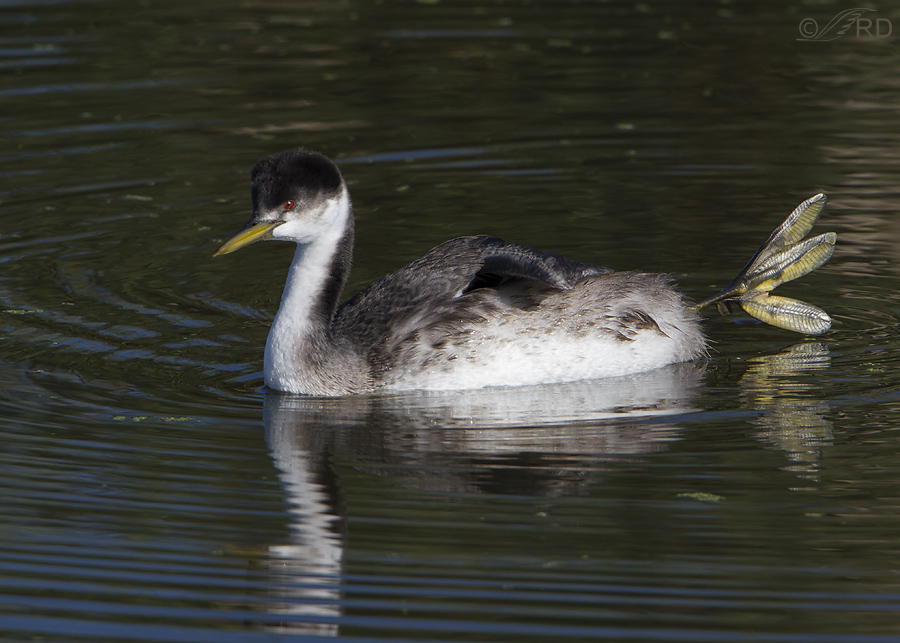
Without warning, and for no apparent reason, they often stick one of their legs and a weird-looking foot out behind them (which I think looks pretty silly).
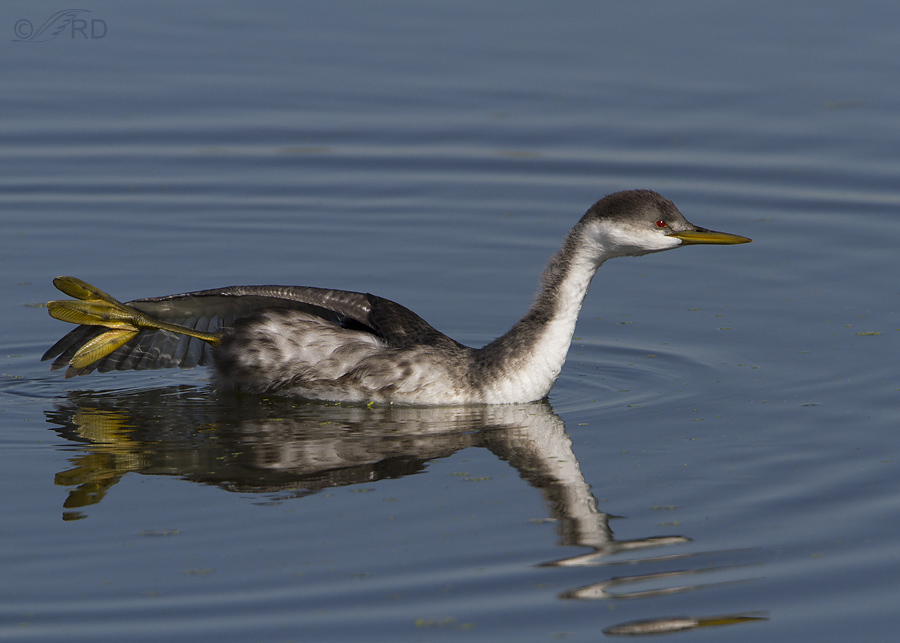
Sometimes they’ll do a simultaneous wing stretch, but only rarely.
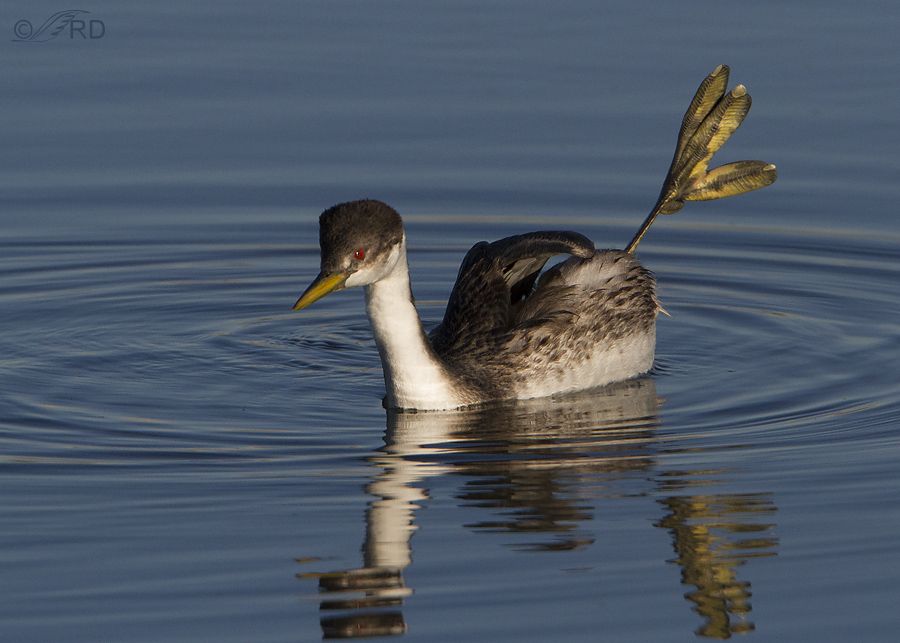
Occasionally they’ll hold the foot high in the air for quite a while and that can look even sillier.
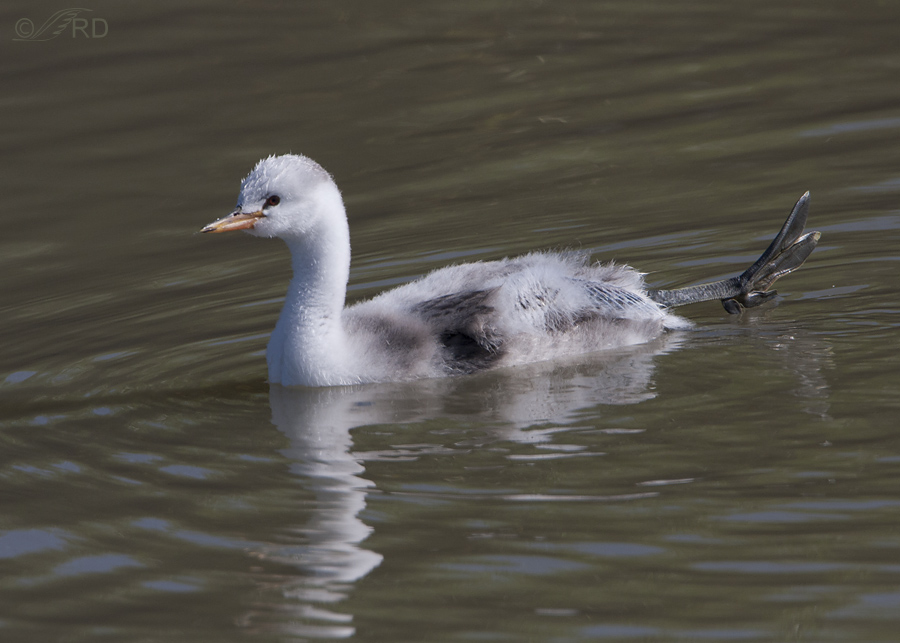
Even the chicks do it.
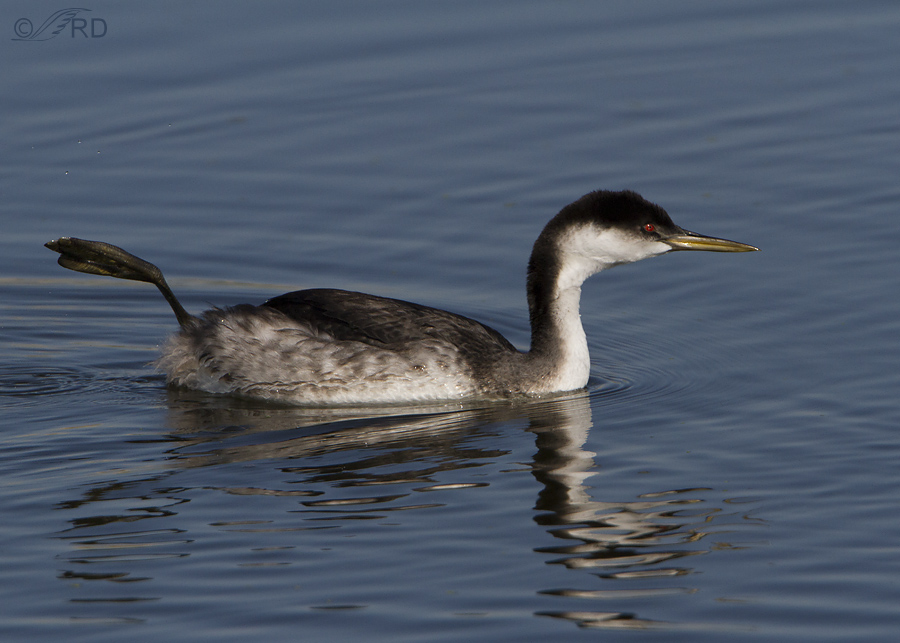
But typically they only leave the foot behind them for a few seconds, usually shaking it as you can see here from the tiny water droplets flying through the air and hitting the water…
and then they either tuck the leg and foot under a wing (most common by far) or lay them across the top of their back. Obviously this contortionist maneuver would be impossible if the legs were attached in the “normal” position beneath the body. Just imagine a duck trying to accomplish this neat trick.
Over the years I’ve seen grebes do this many hundreds of times and never understood it, so recently I did some research. It turns out that this behavior helps to prevent body heat from being lost to the water from that huge foot that almost acts as a radiator. They stick the foot back behind them, shake the water off, then place it under the wing to warm it and prevent further heat loss. Sometimes on sunny days they leave the foot on top of their back (rather than beneath a wing) to absorb the heat from the sun.
Bird behaviorists even have a name for the maneuver – it’s called “foot-shipping“ (one definition of shipping is “to put in place for use”).
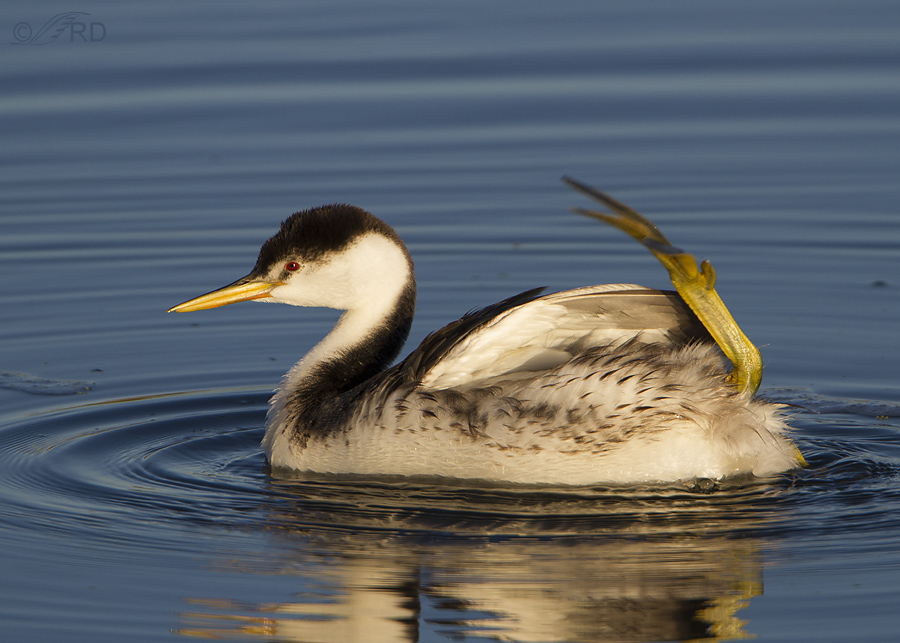
Here’s a look at a grebe through the entire process of “shipping” its foot. The wing is raised, the foot and leg come over the top of the body from behind…
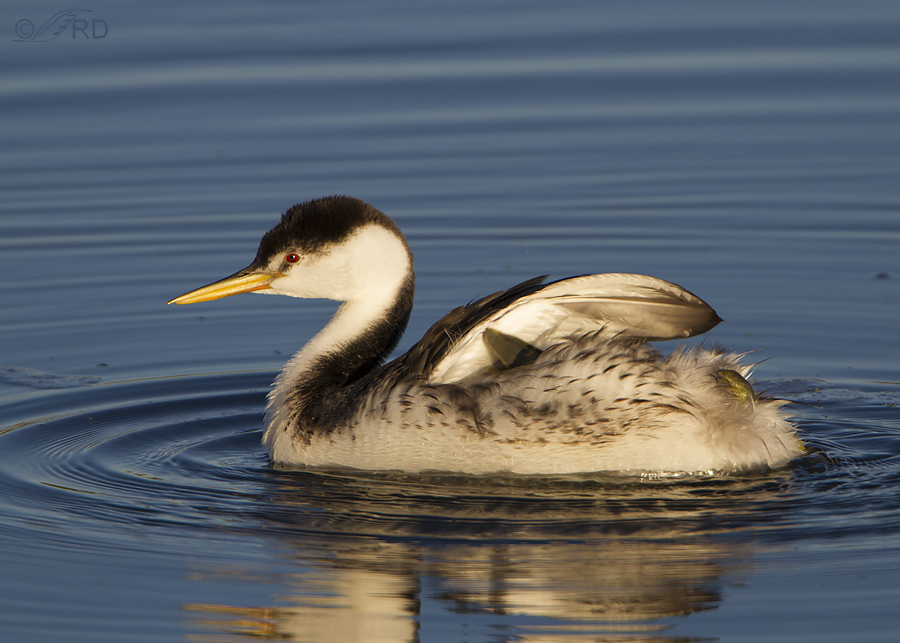
and are neatly tucked under the wing before the wing returns to its normal position.
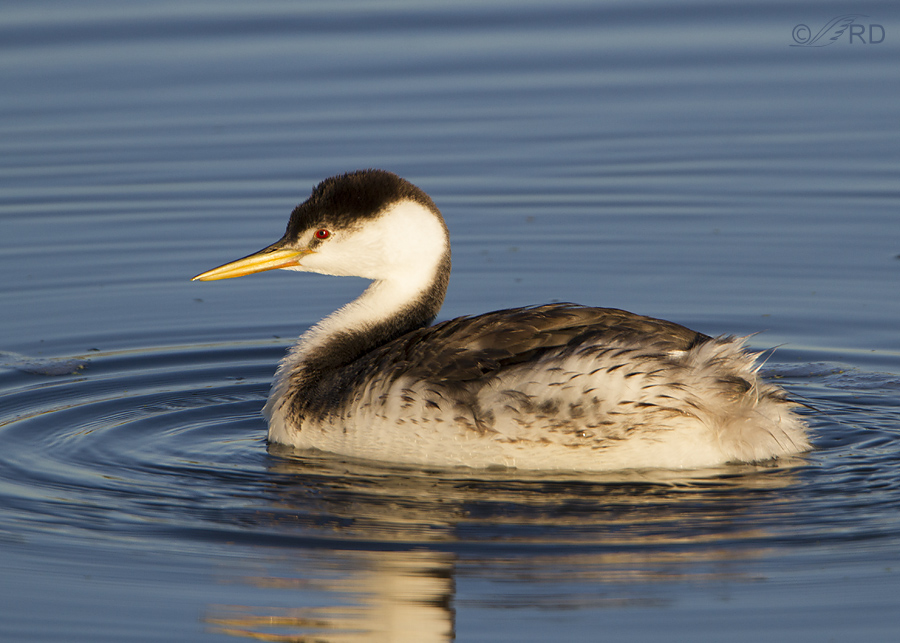
And literally a split-second later you’d never know that the leg and foot are under the wing.
This all happens very fast. I doubt most folks notice the foot going under the wing and once it’s there you’d simply assume both legs are in the water below and behind the bird again. And they’re very good at paddling with only one foot which is what they’re often doing when they aren’t fishing or doing something else active.
I’m delighted to have finally learned the answer to this little mystery that has befuddled me for so long and I thought some of my readers might be interested in what I found.
I’d always assumed it was some form of bizarre leg stretch but once again making an assumption turned out to be a big mistake.
Ron


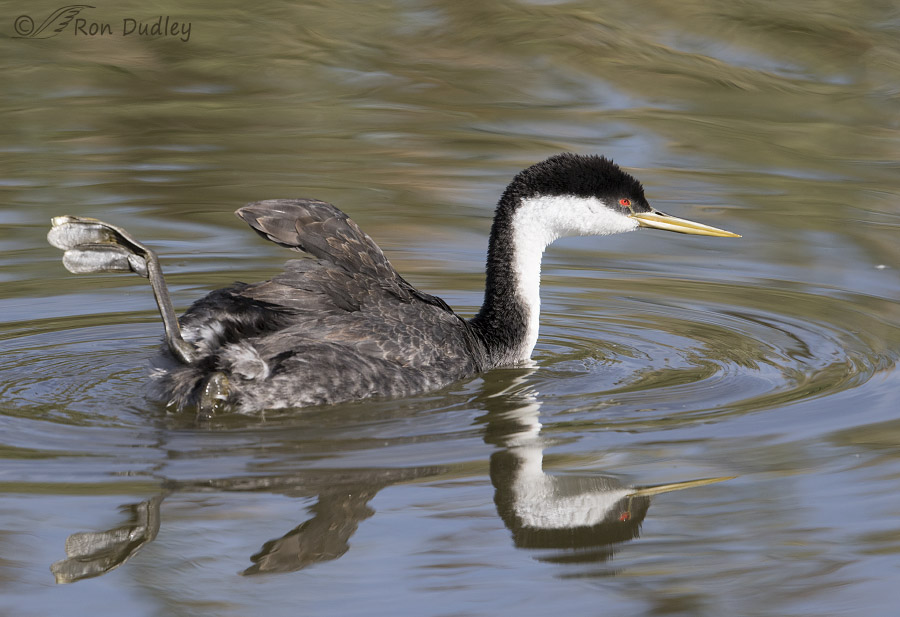
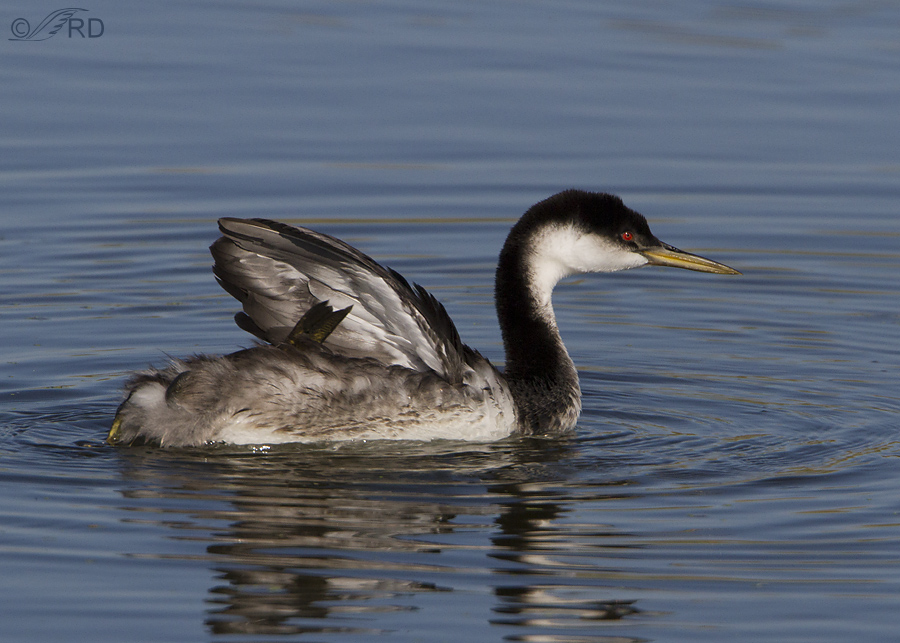
Thanks for the interesting post! Love learning new things and this certainly qualifies.
Good! Thanks, Joanne.
New yoga position? The Grebe? 🙂
Fascinating behavior, though makes me wonder why they have issues when ducks don’t seem to have that problem.
With their anatomy ducks don’t have the option to do this – at least that would be my guess.
I knew the reason why but I did not know it had a name, “foot shipping”. I learned something new today. Fantastic photos of those big lobed toes!
Thank you, April.
Absolutely fascinating. I was totally ignorant – and have (as I so often do) learnt from you.
Love their way of dealing with this very strange adaptation.
And given how often I fall over, perhaps I am channelling my inner Grebe.
I’m glad you enjoyed the post. Thanks, EC.
EC, when I take a nosedive, I figure I’m channeling my inner “coot-on-the-ice.” 😉
Sadly I channel unco-ordinated klutzdom all too often.
WHO IS THE WISE GUY THAT STUCK EXTRA LEGS AND CRAZY-LOOKING FEET ONTO THOSE POOR BIRDS AT THOSE ODD ANGLES???
🙂
Gee that is just crazy and so funny. I was thinking it was done to regulate body temps, and then you confirmed it. Beautiful pictures.
Thank you, Trudy.
Once again you taught me something new. This is very interesting information. I wonder what the other ducks think when they see that foot in the air lol. It does look silly. Thank you for sharing.
Other birds seem to ignore it, Debbie – but who knows what they’re really thinking…
This. Is. So. COOL! Thank you for another fascinating lesson about Grebes! They seem to be among the quirkiest of waterfowl. I had no idea that they brought their feet under a wing or on their backs to warm them, nor that their feet were lobed. I wonder if that’s part of the chicks’ back riding too — a way to get their little tootsies and tushies warm. 🙂 The last series makes me think of the way a motorized convertible top comes down and then goes under the flip cover.
P.S. I sent you a Grebe-related link via email. 😉
“a way to get their little tootsies and tushies warm”
Could be, Marty. When they’re small they’d have a more difficult time keeping warm than the adults, partly because of size and partly because they don’t have as many insulating feathers.
Thank you for that info on Foot Shipping, very interesting. I took pictures of a group of six Swans(5 adults & 1 juvenile). One day one of the adults was holding one leg & foot up in similar position to the Grebe. I thought it to have an injury but went back the next day, all six swans were there & all legs were in normal positions. Would this be the Foot Shipping or something else?
Thanks, Shirley. I suspect what you saw was something else.
These.are some of the strangest bird photos I’ve seen…those crazy feet seem to belong to some other birds…they just don’t fit….
Agreed, Patty.
Absolutely fascinating post. Clearly an adaptation to living in water and being so ill-suited to land. Thanks for reposting this – I love learning new things.
Thanks, Susan. I actually watched a grebe trying to walk on land last year. It was heart-wrenching and hilarious at the same time.
Ron, have you seen the grebes do this with both legs/feet at the same time? jake
No, I haven’t seen them shake both feet at the same time, Jake. And it would be next to impossible to know if they had both legs tucked at the same time but I doubt they would do that because then they couldn’t paddle.
Just fascinating ! I really do love all the weird and wonderful things you offer ( as well as the beautiful ones ! ) that you offer daily in your blog……..that huge upraised foot resembles a
ornamental fan –like servants used to use to cool royalty in centuries past– except this one is to WARM its bearer !
Interesting observation about the fan, Kris. Thank you.
Very interesting. Thanks for once again teaching me something new! At first glance, I thought this bird was shot with an arrow!
Thanks, Sheila. I can see how one could easily get that impression.
Amazing series Ron! Wonderful!
Charlotte
Thanks, Charlotte.
Cool! Thx for a wonderful series of photos and education! It certainly looks weird but makes perfect sense! They are quite the contortionists for sure. 🙂
Judy, those legs must be incredibly flexible – makes me think they must have some unique anatomy in their leg joints and ligaments.
I noticed the color of the legs varies – is that due to age or “just cuz”
It’s largely a function of if we’re looking at their upper surface or their lower surface, Judy. This from BNA Online:
“In adults lower surface of tarsi and toes black, upper surface yellow green or yellow orange. In hatchlings legs and feet “nearly black” (Ratti 1977) or “mostly slaty, the lobes somewhat greenish” (Palmer 1962); upper surface becomes olive green in juveniles and obtains adult coloration in first year.”
Thx – can see the upper vs. lower in a couple of the photos and the chick’s are all dark. Always something to learn. 🙂